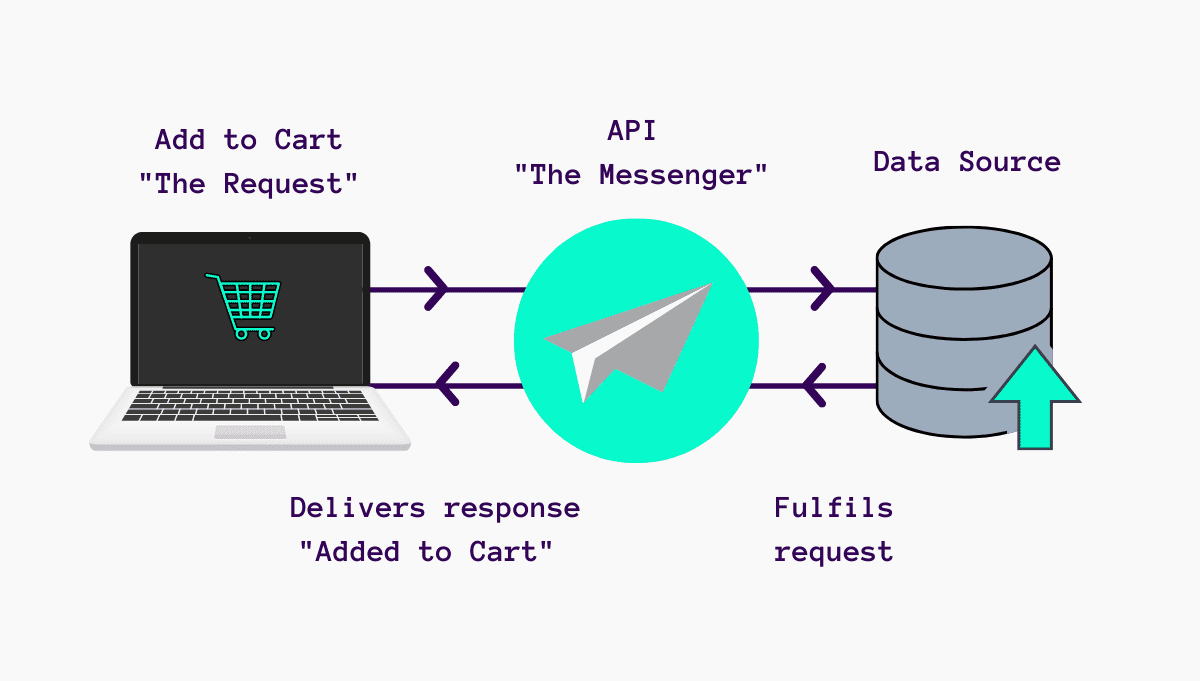
Today, we are decoding the term and discussing the importance of functioning APIs – as well as Kooomo’s development of our own APIs.
>Share this post<

by Lauren Cassidy
August 12, 2020
If you’re working in eCommerce, you have probably heard the term API thrown around quite frequently. However, if you are a layman (ie. not a developer) you may not be too familiar with its purpose and/or vitality.
Today, we are decoding the term and discussing the importance of functioning APIs – as well as Kooomo’s development of our own APIs.
So let’s start with the basics.
Today, we are decoding the term and discussing the importance of functioning APIs – as well as Kooomo’s development of our own APIs.
So let’s start with the basics.
What is an API and how does it work?
API stands for Application Programming Interface and is the software that allows applications to communicate with each other. Simply put, the API is the middle man between your request on a site and the computers’ fulfilment of that request. An interaction on the webpage, like the click of an Add to Cart button, sends a request to the server. The server receives the request and might perform some actions based on the data in the request such as; finding the product, confirming availability, adding the product to the customers cart, and reserving stock. The server sends a response back to the webpage. The webpage might use the data in the response to update the cart total and let the customer know their product has been added to their cart.”
For example, let’s take a look at the action of adding something to your cart.
Data is passed between the webpage and the server in a format called “JSON” and there are four basic request methods that can be made with API:
GET – Gathers information (Pulling all Coupon Codes)
PUT – Updates pieces of data (Updating Product pricing)
POST – Creates (Creating a new Product Category)
DELETE – (Deleting a blog post)
So why are they important? APIs are responsible for the performance of your site and can be held accountable for successful UX. Within the retail sector, in particular, consumers have become accustomed to instantaneous and flexible processes, Providing customers with accurate and fast information is what APIs help businesses do, and if done correctly can help you maintain a good reputation for use and reliability.
GET – Gathers information (Pulling all Coupon Codes)
PUT – Updates pieces of data (Updating Product pricing)
POST – Creates (Creating a new Product Category)
DELETE – (Deleting a blog post)
So why are they important? APIs are responsible for the performance of your site and can be held accountable for successful UX. Within the retail sector, in particular, consumers have become accustomed to instantaneous and flexible processes, Providing customers with accurate and fast information is what APIs help businesses do, and if done correctly can help you maintain a good reputation for use and reliability.
Kooomo and API’s
Our team of developers is continuously creating APIs in order to improve our platform and the services we offer. APIs essentially make the platform better and the more we have means more information can be carried about the users’ needs to the system and in turn, find what they need. Kooomo also provides best-in-class technologies across sales, marketing, project management, payment gateways, and courier companies – with which our clients can integrate with also.
There are two types of API’s we integrate with: Tech partners and our own end to end API. Tech partners include many of the integrative apps we offer (ie. pre-existing API’s that can be applied to your web store depending on your needs/wants.)
Supporting “Headless eCommerce”
Headless eCommerce is a term that is being discussed more frequently and being requested more often. We’ve delved into the pros and cons of this functionality in a previous post, but let’s quickly discuss its meaning and why working towards its provision at Kooomo.
Definition
Headless eCommerce is the separation of the front end and back end of an eCommerce website. This allows each to operate independently so that changes on one end do not require reciprocal changes on the other. They simply communicate with each other through the use of APIs.
This means that headless can lessen the IT dependency (amount of work needed in the back end) for user experience and user interface projects (the front end). Therefore, UX changes, which only impact the front-end can happen faster because they don’t require heavy legwork in the back-end.
Creating our own end to end APIs allows our clients to go about making their own sites without having to create their own code. We are creating a “headless eCommerce” engine to our platform so that merchants have a choice to enjoy our functional rich and well-tested platform. Our own APIs are being added to our front-end engines to enrich the customer journey and complete the experience. Therefore, clients are set to have greater creative freedom over their site.
Our cloud-based technology allows for multiple API requests to be combined into scenarios to deliver seamless customer journeys across multiple channels – be it via their own website, mobile app, or any other device! You can find our own platform API here.
Conclusion
So, there you have it. 3 little letters that carry a lot of meaning… Literally. APIs are the glue that holds websites together and determines the customers UX. This, in turn, determines the success of your website as consumers are more likely to return to websites that had minimal pain points – quick loading times, instantaneous actions, and a clear and concise journey.
We’re happy to discuss your integrations if you wish to get in touch with us or you can visit our website for more information.
So, there you have it. 3 little letters that carry a lot of meaning… Literally. APIs are the glue that holds websites together and determines the customers UX. This, in turn, determines the success of your website as consumers are more likely to return to websites that had minimal pain points – quick loading times, instantaneous actions, and a clear and concise journey.
We’re happy to discuss your integrations if you wish to get in touch with us or you can visit our website for more information.
More to explore
Here’s an overview of the latest improvements that are now available in the Kooomo platform.
In the next few years, we are foreseeing an impressive increase for the global retail industry. While this can be beneficial for the global eCommerce industry, it also means that there will be more competition, as well.

 en
en 

